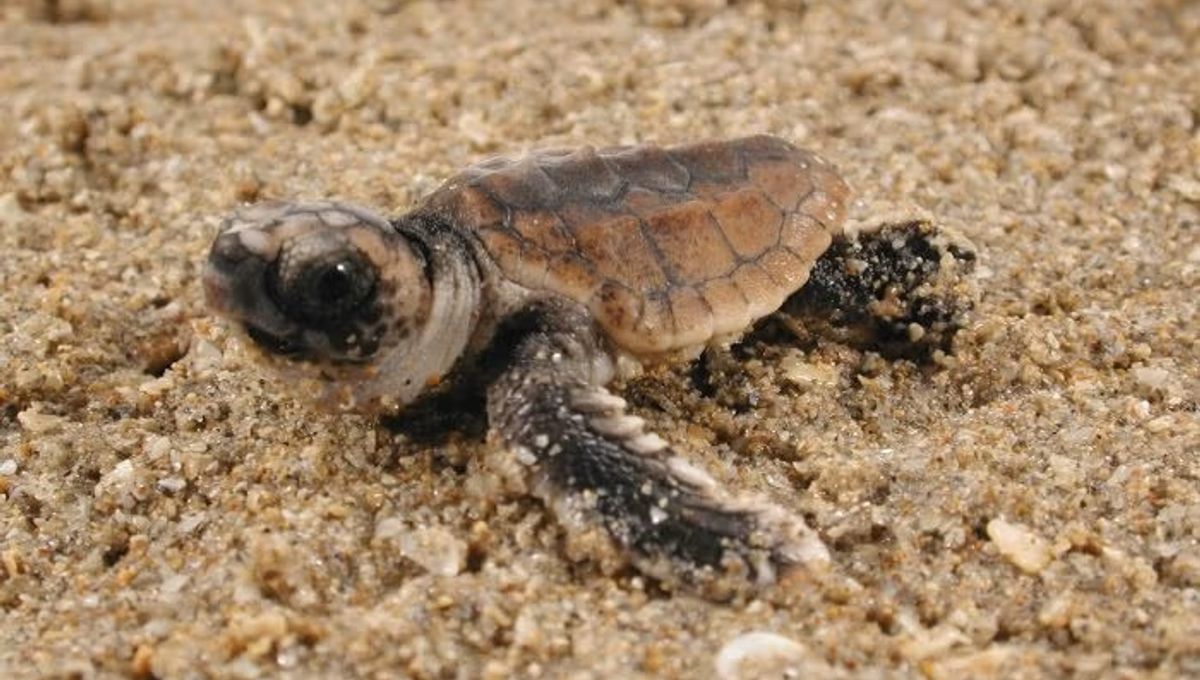
Loggerhead turtles can recognize the magnetic signatures that they associate with getting a nice meal – and do an adorable little dance when they do! That’s according to new research that suggests that these turtles use Earth’s magnetic field as a map and a compass in two different ways.
ADVERTISEMENT GO AD FREE
“Our study investigated for the first time whether a migratory animal can learn to recognize the magnetic signatures of different geographic areas,” first author Dr Kayla Goforth – who was based at the University of North Carolina at Chapel Hill at the time of the study, now at Texas A&M University studying monarch butterflies – said in a statement. “Researchers have speculated for decades that animals can learn magnetic signatures, but this is the first empirical demonstration of that ability, so it fills in an important gap in our knowledge.”
Loggerhead turtles choose widely dispersed locations to feed in – often returning to them after their long migrations and displacements. But how do they know in which direction to go forth and swim? Goforth and colleagues started out by spending two months conditioning juvenile turtles, feeding them while they were in one magnetic field and not feeding them in another.
The researchers noticed that turtles excitedly anticipating a meal performed what they call “turtle dance” behavior. Want to bust a move like a loggerhead next time you’re at a dinner party? The team write in the paper that “Hallmarks of the behaviour include some or all of the following: tilting the body vertically, holding the head near or above water, opening the mouth, rapid alternating movement of the front flippers, and, occasionally, even spinning in place.”
“That’s how we figured out what to measure, just by watching them do this as we were feeding them in the lab,” Goforth told Michael Lananna in another statement.
Even when no food was to be had, turtles in the magnetic field they associated with food still showed “significantly higher levels of turtle dance behavior” than in the no-food field, and still appeared to be able to discern between the two four months after the conditioning had ended.
One group of turtles were conditioned a second time with a different set of fields, and were shown to replicate the behavior. These results indicate that the turtles can remember the magnetic signature of their feeding grounds for extended periods of time, as well as being able to do so for multiple sites.
ADVERTISEMENT GO AD FREE
“The ability to distinguish among magnetic fields of different geographic areas likely explains how many animals – not just sea turtles – can navigate long distances to specific locations,” said study co-author Kenneth Lohmann, the Charles P. Postelle Jr. Distinguished Professor of Biology at UNC-Chapel Hill.
However, it doesn’t end there. The turtles use their magnetic senses to navigate in two different ways; for positional information, like a map; and for directional information, like a compass. The team delved deeper into the differences between the two by using broadband radiofrequency fields “known to disrupt magnetic sensing in birds and other animals”.
“Remarkably, the antenna system we built for the turtle study is nearly identical to that of an unrelated dark matter search we had worked on,” said co-author Reyco Henning, professor in UNC-Chapel Hill’s Department of Physics and Astronomy.
They repeated the turtle dance test, finding that radiofrequency had no impact on their magnetic map sense – but it was a different story for their compass sense, which hatchlings use to swim in the right direction. The turtles swam towards a light in one magnetic field, and after 10 minutes the light was switched off and the field was switched to another. When the radiofrequency field was activated, the turtles’ orientation was “statistically indistinguishable from random”, whereas without it they were “significantly oriented”.
ADVERTISEMENT GO AD FREE
“It suggested there are two different mechanisms for the magnetic map and compass, and they might have evolved separately,” Goforth explained. The researchers write that a “reasonable working hypothesis is that the compass sense relies on chemical magnetoreception, whereas the map sense relies on an alternative mechanism.”
“The big question is always the mechanism,” Goforth said. “What’s the mechanism and what is the sensor? We know that for the visual sense, you have eyes; for the sense of smell, you have a nose; and for hearing, you have ears. But no receptor like that has been identified for the magnetic sense, and the mechanism remains unknown.”
“We’ve known for 20 years that sea turtles have magnetic maps and now, by showing that they can learn new locations, we have learned how the maps might be built and modified,” added co-author Catherine Lohmann, biology professor at UNC-Chapel Hill. “It is amazing that sea turtles have access to a wealth of invisible information that they use to navigate in ways that are hard for us to even imagine.”
The findings are published in Nature.
Source Link: Watch Turtles Boogie When Magnetic Fields Say Food Is Near